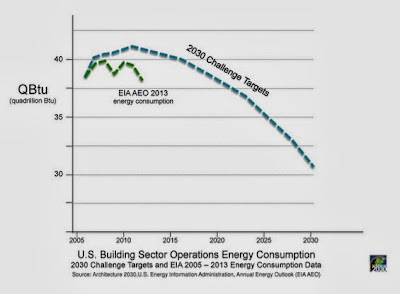The U.S. is set to
construct roughly 60 billion square feet of new buildings by 2030. But when
Edward Mazria of Architecture 2030 looked at projections for electricity
consumption in those buildings, he found something
surprising: energy needs are actually falling.
In theory, that means we won't need to develop new power plants to service
those buildings. (source:
Greentech Efficiency, Steven Lacy)
It
becomes an even more powerful proposition, and more important to our national
security, economy and environment, when we use the power of efficiency to
replace oil.
We can drive our cars with the energy we save in our home.
In modern homes, there can be well over 100 light bulbs inside and outside. Gone are the days of one light bulb in the middle of the room, or one lamp fixture with one light bulb, or one porch light. Outdoor areas can become lighting masterpieces with dozens of lights in both the front and back yards set on timers illuminating for 2-6 hours per night.
Using a modern home
and our lifestyle as an example, I estimate that a 1/3 of those 100 light
bulbs are on 4 hours a day, 1/3 are on 2 hours a day and 1/3 are
seldom or never on. For an average of all the bulbs, two hours per bulb is a fair estimate. Your family or home may vary. That
is 200 bulb hours per day. Assuming an average bulb rating of 60
watts, we consume 12 kwh a day, 360 kwh a month, or 4300 kwh per year
in lighting our modern well appointed home.
What happened when we
switched those to LED?
The 60 watts that an incandescent bulb used was reduced to 8 watts using the LED bulb. The 200 bulb hours a day for our modern house is now reduced to 1.6 kwh per day, 48 kwh per month, or 585 kwh per year.
That’s a
savings of 3,715 kwh a year switching from incandescent to LED.
With an efficient electric car like the Honda Fit EV or the upcoming BMW I3, 4.5 miles traveled per kwh is a good rule
of thumb. To drive these cars a typical
12,000 miles a year requires 2700 kwh a year. So saving 3715 kwh via the lightbulbs, and then using 2700 kwh to drive 12,000 miles in one car leaves us with a extra 1000 kwh to use for our second car.
This simple example is just for lighting our home, A few months ago we replaced our 6 year old 50” plasma TV that warmed the whole living room and used $15 a month of electricity with a 50” LED that uses $15 a year. Computers, appliances, smart thermostats and every electronic gizmo in the home are all getting more efficient each year.
This simple example is just for lighting our home, A few months ago we replaced our 6 year old 50” plasma TV that warmed the whole living room and used $15 a month of electricity with a 50” LED that uses $15 a year. Computers, appliances, smart thermostats and every electronic gizmo in the home are all getting more efficient each year.
According to the EIA, in 2011 the average home in America used 11,280 kwhs per year. http://www.eia.gov/tools/faqs/faq.cfm?id=97&t=3
Without much effort or cost, it would be very easy for the average home dweller to save the 2700 kwhs a year to power the car in the garage 12,000 miles a year.
We are entering a new energy world where optimized efficient home construction coupled with solar PV generation, will allow for a net zero energy operations cost for both the home and the two cars in the garage, with a capitol cost of construction payoff in less than 5 years. In some parts of the country that's already a reality.
Tip: Replace the lightbulbs that you use most often first, those that you seldom or never use don't need to be replaced.
Cheers
Peder
About the author:
Peder Norby is San Diego County Planning Commissioner. He and his wife, Julie, received the 2007 Energy Excellence Award from the California Center for Sustainable Energy for the construction of their net-zero energy home in Carlsbad, Ca. They have driven more than 80,000 miles powered by sunshine in their two plug-in electric vehicles.
Without much effort or cost, it would be very easy for the average home dweller to save the 2700 kwhs a year to power the car in the garage 12,000 miles a year.
We are entering a new energy world where optimized efficient home construction coupled with solar PV generation, will allow for a net zero energy operations cost for both the home and the two cars in the garage, with a capitol cost of construction payoff in less than 5 years. In some parts of the country that's already a reality.
Tip: Replace the lightbulbs that you use most often first, those that you seldom or never use don't need to be replaced.
Cheers
Peder
About the author:
Peder Norby is San Diego County Planning Commissioner. He and his wife, Julie, received the 2007 Energy Excellence Award from the California Center for Sustainable Energy for the construction of their net-zero energy home in Carlsbad, Ca. They have driven more than 80,000 miles powered by sunshine in their two plug-in electric vehicles.

